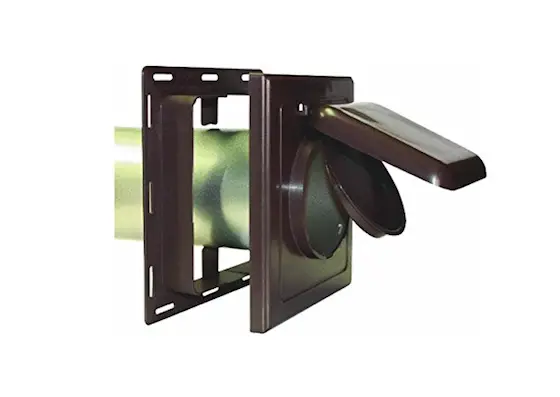Clothes Dryer Vents

Look at the double doors. This keeps pests out and prevents cold air from backdrafting into your home. CLICK THE IMAGE to order it now.
DEAR TIM: I just discovered that my clothes dryer exhaust in my new home dumps into my attic near a roof vent. There is a large collection of lint in the attic. When asked, the builder states that this is perfectly acceptable. Is he correct? Is the solid vent piping better than the flexible piping? Can you vent a dryer through a roof or a soffit with minimal problems? What about those interior vent kits that claim energy savings? Is that an option? Bob E., Troy, MI
DEAR BOB: I see inferior dryer vent installations like yours on a monthly basis. Dryers that exhaust into garages and crawl spaces are also potential problems. Ask your builder if your local building inspector finds his installation "acceptable". Virtually every model building code addresses clothes dryer exhausting. The codes mandate that dryer exhaust needs to be ducted outdoors. Terminating the exhaust pipe near an attic vent does not meet this requirement, plain and simple.
Clothes dryer exhaust can cause major problems within a house. In your case you have two imminent hazards. One is a fire hazard with respect to the massive quantities of exposed fabric lint dust. An open flame could turn your attic into an inferno within seconds. I also suspect that you will have mildew growing in short order. The dryer pumps a large amount of humid air into the attic with each load of laundry that is dried. This warm, moist air is exactly the tropical climate that mildew thrives upon.

I have found that it is often best to vent fans and dryers through the roof. I urge you to watch this video of mine to see how easy it is to install the correct vent-cap flashing on a roof. Have no fear - if done right you will have no leaks.
Interior vent kits do not meet most model building codes and they inject vast quantities of humid air into your home. Condensation on windows, within exterior walls, and in attics can result from this method of dryer venting. This trapped moisture can cause wood rot and mildew problems.
Dryer venting is not as simple as it seems. The blower motor within a dryer can only push the moist air so far. If you exceed this limit, the dryer will not dry clothes properly and the vent piping can clog easily with lint. The exhaust hood design, the type of exhaust pipe used (smooth metal vent vs. corrugated/flexible metal pipe), and the number of bends in the exhaust piping create friction that slows the air leaving your dryer.
Smooth metal vent pipe and exterior exhaust hoods that have openings of sixteen square inches or more offer the least resistance to air flow. If you have no bends or turns in the exhaust piping, you can place the dryer up to 64 feet away from the exhaust hood. The addition of four 90 degree bends allows you to have only 27 feet of straight pipe in between the dryer, the bends and the exhaust hood. Exhaust hoods with narrow mouths often have only ten to twelve square inch openings. If you use one of these with flexible piping that has four bends in it you can only have fifteen feet of straight piping between the bends, dryer, and exhaust hood!
Author's Note: Since this article was written, the Code has changed. Mark D. of Laconia, NH, emailed me and stated that "Since the International Residential Code states "Max length of 25' (less for elbows)", why do you say 64'?" Be sure to check the most recent Code for the correct lengths. Codes can be updated at any time.
You can vent a dryer through a roof if you use the correct exhaust hood. The best hoods are one piece and contain wide flanges that permit a leak proof installation under common asphalt shingles. The hoods include insect screening and a built-in damper that stops outside air and bumble bees from blowing or flying back into your dryer. Venting dryers through soffits is not a good idea. Humid air can often find its way into your attic through soffit vents.
Because you live in a cold climate you need to make sure your builder insulates the metal dryer pipe when he connects it to the new special roof exhaust hood. Without this insulation, the metal pipe will chill the moist air within the pipe creating condensation. This liquid water will run down the pipe and possibly leak from the pipe joints or show up as a leak under your dryer. High quality reinforced foil duct tape found at heating and cooling supply houses is the best material to use to secure the insulation to the metal piping and the insulation backing. Standard duct tape can fail in the extreme temperatures found in many attic spaces.
Check to see how your dryer vent pipe was fastened together. If your builder used screws, it was a mistake. The screw shafts inside the piping collect lint and cause additional friction. Manufacturers and building code officials prefer that you use the reinforced foil duct tape in conjunction with special large diameter clamps that squeeze the pipes together.